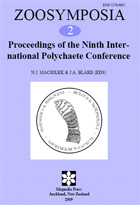Abstract
Eight species of Monticellina are described from intertidal and subtidal sites on the Pacific coast of Costa Rica. Six of these species, M. acunai sp. nov., M. antelaxa sp. nov., M. carrikeri sp. nov., M. elongata sp. nov., M. giribeti sp. nov., and M. setosa sp. nov. are new to science while M. cryptica Blake, 1996 and M. tesselata (Hartman, 1960) have been previously described from California. M. acunai sp. nov. has a wide prostomium, a peristomium with four annulations and denticulate capillary setae with numerous well-developed teeth in both the notopodium and neuropodium. M. antelaxa sp. nov. has a small prostomium, a wide peristomium with three annulations, and a double row of denticulate neurosetae with long fibrillar teeth. M. carrikeri sp. nov. has a wide prostomium, a wide peristomium with three annulations, and denticulate neurosetae with a narrow base and an expanded midsection with numerous, scattered, small teeth. M. elongata sp. nov. has a wide prostomium, an elongate peristomium with six annulations, the first segment joined with the first setiger, and denticulate capillary noto- and neurosetae with coarse teeth. M. giribeti sp. nov. has a wide prostomium, an elongate peristomium with five annulations, an asetigerous first segment joined with the peristomium, and denticulate capillary noto- and neurosetae with fine teeth. M. setosa sp. nov. has a small prostomium, a wide peristomium with five annulations, nuchal organs present within narrow indentations of the overlying peristomium, and denticulate capillary neurosetae with fine teeth. Morphological characteristics that may aid in the differentiation of species within the genus are discussed.

